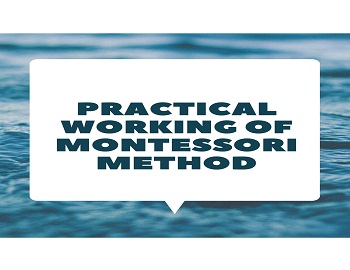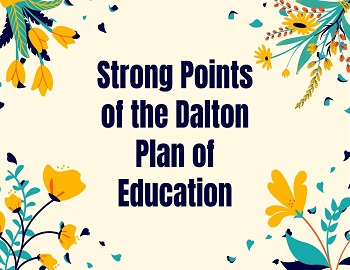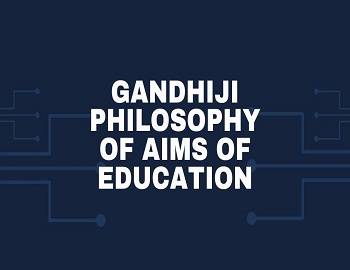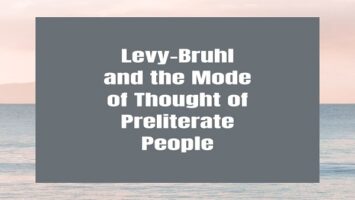Practical Working of Montessori Method:
Whereas Froebel called his school “Kindergarten”, “The Children’s Garden”; Montessori called it “The Children’s House”. The Children’s House is a place where children are taught in an atmosphere that is very conducive to the development of a child’s individuality. There are many rooms and a garden. Children look after the garden. The garden is so planned that the children may play as well as rest over there. The house provides them with an opportunity to live on the open side. There is a main room for study. To this room are attached small rooms such as a bathroom, a lunchroom, a common room, a room for manual work, a gymnasium and a room for taking rest etc. Children are taught in this house to lead a natural and decent life.
There is a “Didactic Apparatus” which brings about the intellectual development of the children. Children have to look after the arrangement and cleanliness of things. They themselves do everything. They dust the rooms and the furniture, wash the clothes, lay their tables and handle the crockery and glassware when serving at a table.
There are three types of exercises for children in Montessori School. They are- Daily life exercises, Exercises for sensory training and Didactic exercises.
(1) Daily Life Exercises- The first phase in the house of children is to take care of themselves. It is based upon the freedom of doing one’s own job. The child is taught to take care of his body; how to dress and undress himself; how to look to his personal cleanliness and hygiene. The children are taught to use the washbasin, to clean their nails, to brush their teeth, to comb their hair, to polish their shoes, to wash their clothes, to dust their rooms, to arrange their furniture, to move furniture from one place to another and to do gardening and clay modelling. Muscular coordination is obtained through gymnastic exercises. Children are asked to walk in lines and balance their bodies. Thus children are given training in motor adjustment and coordinated movements.
(2) Exercises for Sensory Training- Montessori attached much importance to the introduction of sensory training in Education. She devised apparatus to impart sensory training. A few exercises along with training the different senses are given below-
(a) Sense of Touch- Sense of touch may be developed by asking the child to put his hand first in cold and then in hot water. The child will observe and understand the difference between ‘hot’ and ‘cold’. Again cardboard of which one half is smooth and the other half rough are made use of. The children feel both the surface and understand the difference between ‘smooth’ and ‘hard’.
(b) Sense of Hearing- Sense of hearing or sound is developed through music bells and wooden discs. It is also developed by using the closed boxes cylindrical in shape which may be full of material producing sound.
(c) Sense of Weight- Sense of weight may be developed by using wooden blocks and tables of different weights.
(d) Sense of Colour- Sense of colour is developed through coloured cubes, rods and prisms. Children can be asked to sort and grade 64 cards of various colours of wool.
(e) Perception of Size- For perception of size, a series of wooden cylinders are used. They vary in height and in diameter. Similarly, blocks of different sizes and rods of graded lengths may be used.
(f) Sense of Form- It can be developed with the help of various kinds of cubes.
This method of sense training has the following three stages-
- Association of sensory experience with a name. Example- “This is red”.
- Recognition of the object. Example- “Pick up the red”.
- Recalling the experience or the subject. Example- “What colours is this?”
(3) Didactic Exercises or Apparatus- Didactic exercise consists of reading, writing and arithmetic. Preliminary sense training facilitates self-education. In the Montessori system, writing comes first and reading afterwards. According to Montessori, writing requires motor adjustment whereas reading involves superior intellectual activity. As muscles of children are developed in infancy, they can write with ease before they learn to read.
(a) Teaching of Writing- Perfection in writing is attained by the three-fold process-
- Recognition of the forms of letters- During this step, the children pass their fingers round the shape of the letters of alphabet cut in sand ppaer and pasted on cards. Later on, the same exercise is practices with closed eyes.
- Learning of Phonetic Sound- While the children trace the letters, they go on pronouncing the sounds.
- Control of Pen- The child is required to take up a metal frame into which the inset fits. He is asked to place it on a piece of paper and draw a line round it with a coloured chalk. The same process is to repeated. Thus two figures are produced on the paper. With another piece of chalk the pupil fills in these figures. In making the upward and downward strokes the child is taught not to move his pencil or a piece of chalk outside the line. Thus the child will learn the necessary control of pen and writing. Moreover, Montesori stated, “Let us observe an individual who is writing and let us seek to analyse the acts he performs”.
(b) Teaching of Reading- Teaching of reading is facilitated by the teaching of writing. Montessori encouraged silent reading. She was not in favour of loud reading. To her reading meant “Interpretation of ideas from the written signs”. Until the child receives the transmissions and of ideas from the written words, he doe not read.
In the didactic material, reading lessons consist of slips of paper or cards in which the names of familiar objects are written in bold letters. The child is given a card or slip, containing the name of a familiar object. The teacher speaks the word and the child repeats this sound. When the sound is fixed in the mind of the child he is asked to place the card below the objects whose name it bears. Similarly, children can be taught to read sentences describing action or expressing commands.
(c) Teaching of Arithmetic- Arithmetic is taught to the child by taking a stair that has ten rods in it. These rods are of different sizes. These are divided into portions of one decimeter. The portions are alternatively painted red and blue. The child is to count these red and blue portions and thus learn numbers. In this way, four fundamental rules of arithmetic are taught.
Role of Teacher in Montessori System:
In the Montessori system, a teacher has to play a special role. He is to observe, guide and help the students. Students should be given freedom of movement and action. A teacher must be a good observer. He should know when to intervene and when to keep silent. He should provide an environment to the child which facilitates his learning. He should help when his help is sought by the students. If he helps unnecessarily, the purpose of self-education is marred.
A teacher should have a good knowledge of psychology. He should understand the individual differences which are present in children. He should be able to understand the suitability of a child for a particular work. He should tactfully handle the problem of children. He should respect the individualities of children. He should have implicit faith in children and possess a sympathetic attitude. He should be perfect in his subject. According to Montessori, “Virtues and not words are the main qualification of the directress (teacher)”.
Montessori’s Concept of Discipline:
The Montessori system has no place for collective discipline. Discipline must be self-discipline. Montessori’s concept of discipline is that of self-control and self-directed activity. Discipline cannot be imposed from outside. It is not obtained through repressions or commands. It arises from the cultivation of a sense of responsibility in an atmosphere of complete freedom. To secure good discipline, the method and content of instructions should be geared to the needs of children, their interests should be kindled, and education should be child-centred. In the words of Montessori, creative discipline is the most valuable measure for real education.









Comments (No)